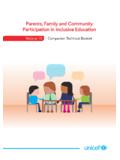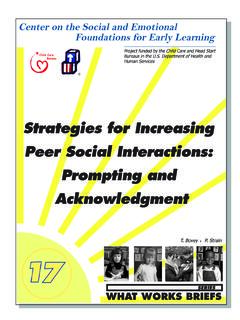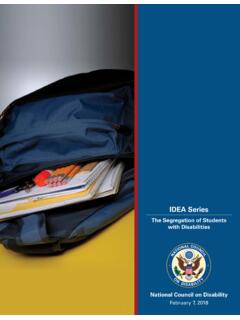Transcription of Special educational needs and disability code of practice ...
1 Special educational needs and disability code of practice : 0 to 25 years Statutory guidance for organisations which work with and support children and young people who have Special educational needs or disabilities January 2015 2 Contents Foreword 11 Introduction 12 About this guidance 12 Expiry or review date 12 To which legislation does this guidance refer? 12 Who must have regard to this guidance? 13 The First-tier Tribunal ( Special educational needs and disability ) 13 Changes from the SEN code of practice (2001) 13 Implementation of the code of practice 14 Special educational needs (SEN) 15 Disabled children and young people 16 Related legislation and guidance 18 1 Principles 19 What this chapter covers 19 Relevant legislation 19 Principles underpinning this code of practice 19 The principles in practice 20 Participating in decision making 20 Supporting children , young people and parents to participate in decisions about their support 21 Involving children , young people and parents in planning, commissioning and reviewing services 22 Parent Carer Forums 22 Identifying children and young people s needs 23 Greater choice and control for parents and young people over their support 24 Collaboration between education, health and social care services to provide support 24 High quality provision to meet the needs of children and young people with SEN 25 A focus on inclusive practice and removing barriers to learning 25 Supporting successful preparation for adulthood 28 2 Impartial information.
2 Advice and support 30 What this chapter covers 30 Relevant legislation 30 Introduction 30 Who are information, advice and support for? 32 3 children 32 Parents 32 Young people 32 What needs to be provided? 33 Additional support 35 Support for parents in HM Armed Forces 36 3 Working together across education, health and care for joint outcomes 37 What this chapter covers 37 Relevant legislation 38 The legal framework 38 Scope of joint commissioning arrangements 39 Establishing effective partnerships across education, health and care 41 Partnership with children , young people and parents 42 Joint understanding: Joint Strategic needs Assessments 43 Responsibility for decision-making in joint commissioning arrangements 44 Using information to understand and predict need for services 45 Joint planning 46 Deciding on shared outcomes 46 Making best use of resources 47 Personal Budgets 48 Joint delivery 49 Joint review to improve service offered 49 Education, Health and Care.
3 Roles and responsibilities 50 Designated Medical/Clinical Officer 50 children s social care 51 Adult social care 52 Health services for children and young people with SEN and disabilities and their families 53 Local authorities role in delivering health services 54 The health commissioning duty 55 Schools and post-16 settings as commissioners 55 Regional commissioning: meeting the needs of children and young people with highly specialised and/or low-incidence needs 55 Local accountability 56 4 The Local Offer 59 What this chapter covers 59 Relevant legislation 59 4 What is the Local Offer? 59 Preparing and reviewing the Local Offer 61 Involving children and young people and parents 61 Involving schools, colleges, health services and others 63 Keeping the Local Offer under review 64 Publishing comments about the Local Offer 65 Taking action in response to comments about the Local Offer 66 What must be included in the Local Offer? 66 educational , health and care provision 68 Training and apprenticeships 73 Transport 73 Support available to children and young people to help them prepare for adulthood 74 Information about how to seek an EHC needs assessment 76 Information, advice and support 77 Publishing the Local Offer 77 5 Early years providers 78 What this chapter covers 78 Relevant legislation 78 Improving outcomes.
4 High aspirations and expectations for children with SEN 79 Equality Act 2010 80 Medical conditions 81 SEN in the early years 81 From birth to two early identification 81 Early years provision 82 Progress check at age two 83 Assessment at the end of the EYFS the EYFS profile 84 Identifying needs in the early years 84 SEN support in the early years 86 Assess 86 Plan 86 Do 87 Review 87 Transition 88 Involving specialists 88 Requesting an Education, Health and Care needs assessment 88 Record keeping 88 Keeping provision under review 88 The role of the SENCO in early years provision 88 5 The role of the Area SENCO 89 Funding for SEN support in the early years 90 6 Schools 91 What this chapter covers 91 Relevant legislation 91 Improving outcomes: high aspirations and expectations for children and young people with SEN 92 Equality and inclusion 93 Medical conditions 94 Curriculum 94 Careers guidance for children and young people 94 Identifying SEN in schools 94 Broad areas of need 97 Special educational provision in schools 99 SEN support in schools 100 Transition 102 Involving specialists 102 Requesting an Education, Health and Care needs assessment 103 Involving parents and pupils in planning and reviewing progress 104 Use of data and record keeping 105 Publishing information.
5 SEN information report 106 The role of the SENCO in schools 108 Funding for SEN support 109 7 Further education 111 What this chapter covers 111 Relevant legislation 111 Introduction 111 Statutory duties on post-16 institutions 112 Equality Act 2010 113 Careers guidance for young people 114 Identifying SEN 114 SEN support in college 114 Assessing what support is needed 115 Planning the right support 115 Putting the provision in place 116 Keeping support under review 116 Expertise within and beyond the college 116 Record keeping 117 6 Funding for SEN support 118 8 Preparing for adulthood from the earliest years 120 What this chapter covers 120 Relevant legislation 121 Introduction 122 Strategic planning for the best outcomes in adult life 122 Duties on local authorities 123 Starting early 124 Support from Year 9 onwards (age 13-14) 124 children and young people with EHC plans: preparing for adulthood reviews 125 Young people preparing to make their own decisions 126 16- to 17-year-olds 127 Support for young people 128 The Mental Capacity Act 128 Planning the transition into post-16 education and training 128 Careers advice for children and young people 130 High quality study programmes for students with SEN 130 Pathways to employment 131 Packages of support across five days a week 132 Transition to higher education 133 Young people aged 19 to 25 135 Funding places for 19- to 25-year-olds 135 Transition to adult health services 136 Transition to adult social care 136 Transition assessments for young people with EHC plans 137 Continuity of provision 138 EHC plans and statutory care and support plans 138 Personal Budgets 139 Leaving education or training 140 9 Education.
6 Health and Care needs assessments and plans 141 What the chapter covers 141 Relevant legislation 141 Introduction 142 Requesting an EHC needs assessment 143 Considering whether an EHC needs assessment is necessary 144 Principles underpinning co-ordinated assessment and planning 147 Involving children , young people and parents in decision-making 147 Support for children , young people and parents 149 7 Co-ordination 149 Sharing information 150 Timely provision of services 150 Cross-agency working 151 Looked after children 151 Timescales for EHC needs assessment and preparation of an EHC plan 151 Advice and information for EHC needs assessments 155 Deciding whether to issue an EHC plan 157 Decision not to issue an EHC plan 159 Transparent and consistent decision-making 159 Writing the EHC plan 160 Content of EHC plans 161 Outcomes 162 What to include in each section of the EHC plan 164 Agreeing the health provision in EHC plans 170 Responsibility for provision 170 The draft EHC plan 171 Requests for a particular school.
7 College or other institution 172 Where no request is made for a particular school or college or a request for a particular school or college has not been met 174 Reasonable steps 175 Requesting a Personal Budget 178 Mechanisms for delivery of a Personal Budget 179 Setting and agreeing the Personal Budget 179 Scope of Personal Budgets 181 Use of direct payments 183 Finalising and maintaining the EHC plan 185 Maintaining Special educational provision in EHC plans 186 Maintaining social care provision in EHC plans 187 Maintaining health provision in EHC plans 188 Specific age ranges 188 All children under compulsory school age 188 children aged under 2 188 children aged 2 to 5 189 Young people aged 19 to 25 190 Transfer of EHC plans 192 Transfers between local authorities 192 Transfers between clinical commissioning groups 193 Reviewing an EHC plan 194 8 Reviews where a child or young person attends a school or other institution 195 Reviews where a child or young person does not attend a school or other institution 197 Reviews of EHC plans for children aged 0 to 5 198 Transfer between phases of education 198 Preparing for adulthood in reviews 199 Re-assessments of EHC plans 200 Requesting a re-assessment 200 The re-assessment process 201 Amending an existing plan 201 Ceasing an EHC plan 202 Disclosure of an EHC plan 205 Transport costs for children and young people with EHC plans 206 10 children and young people in specific circumstances 208 What this chapter covers 208 Relevant legislation 208 Looked-after children 209 Care leavers 211 SEN and social care needs .
8 Including children in need 211 children s social care 211 Power to continue children s social care services to those aged 18 to 25 213 children and young people educated out of area 214 children and young people with SEN educated at home 214 children with SEN who are in alternative provision 216 children and young people in alternative provision because of health needs 218 children of Service personnel 219 Action to take in respect of Service children with SEN 219 First-tier Tribunal (SEN and disability ) 221 Further information 221 children and young people with SEN who are in youth custody 222 Relevant legislation 222 What this section covers 222 Introduction 223 Summary of statutory requirements 223 Sharing information 225 Education for children and young people in youth custody 225 Healthcare for children and young people in youth custody 226 Requesting an EHC needs assessment for a detained person 227 9 Considering whether an assessment of post-detention education, health and care needs is necessary 227 Advice and information for an assessment of post-detention education, health and care needs 229 Preparing an EHC plan for a detained person in custody 233 Provision of information.
9 Advice and support 234 Partial assessment on entry to or exit from custody 235 Transfer between places of relevant youth accommodation 236 Appeals and mediation 236 Keeping an EHC plan and arranging Special educational provision 237 Arranging health care provision for detained children and young peopl with EHC plans 239 Monitoring provision in custody 240 Review on release from youth custody 240 Moving to a new local authority on release 241 Looked after children remanded or sentenced to custody 241 Transition from youth justice to a custodial establishment for adults 242 Education on release for those in a custodial establishment for adults 242 Cross-border detention 243 11 Resolving disagreements 244 What this chapter covers 244 Relevant legislation 244 Principles for resolving disagreements 245 Early resolution of disagreements 248 Disagreement resolution arrangements and mediation 248 Disagreement resolution services 248 Contracting disagreement resolution services 250 Mediation 251 Contracting services for mediation and mediation information 252 Routes to mediation 252 Mediation on matters which can be appealed to the Tribunal 252 Mediation advice before mediation 253 Exceptions to the requirement to contact a mediation adviser 254 Going to mediation about matters which can be appealed to the Tribunal 254 Mediation on the health and social care elements of an EHC plan 255 Effective mediation 257 children and young people in youth custody 258 Registering an appeal with the Tribunal 258 10 Parents and young people s right to appeal to the Tribunal about EHC needs assessments and EHC plans 258 The First-tier Tribunal (SEN and disability )
10 258 The role and function of the Tribunal 259 Who can appeal to the Tribunal about EHC needs assessments and plans 259 What parents and young people can appeal about 259 Conditions related to appeals 260 Decisions the Tribunal can make 260 How parents and young people can appeal 261 disability discrimination claims 262 Exclusion 262 Legal aid 264 Complaints procedures 265 Early education providers and schools complaints procedures 265 Complaints to the Secretary of State 266 Complaints to Ofsted 266 Post-16 institution complaints 267 Local Authority complaints procedures 268 Local Government Ombudsman 268 The Parliamentary and Health Service Ombudsman 269 Judicial review 270 NHS Complaints 270 Complaints about social services provision 271 Annex 1: Mental Capacity 273 Annex 2: Improving practice and staff training in education settings 276 Glossary of terms 278 References 287 11 Foreword From the Parliamentary Under-Secretary of State for Health and the Parliamentary Under-Secretary of State for children and Families Our vision for children with Special educational needs and disabilities is the same as for all children and young people that they achieve well in their early years, at school and in college, and lead happy and fulfilled lives.












